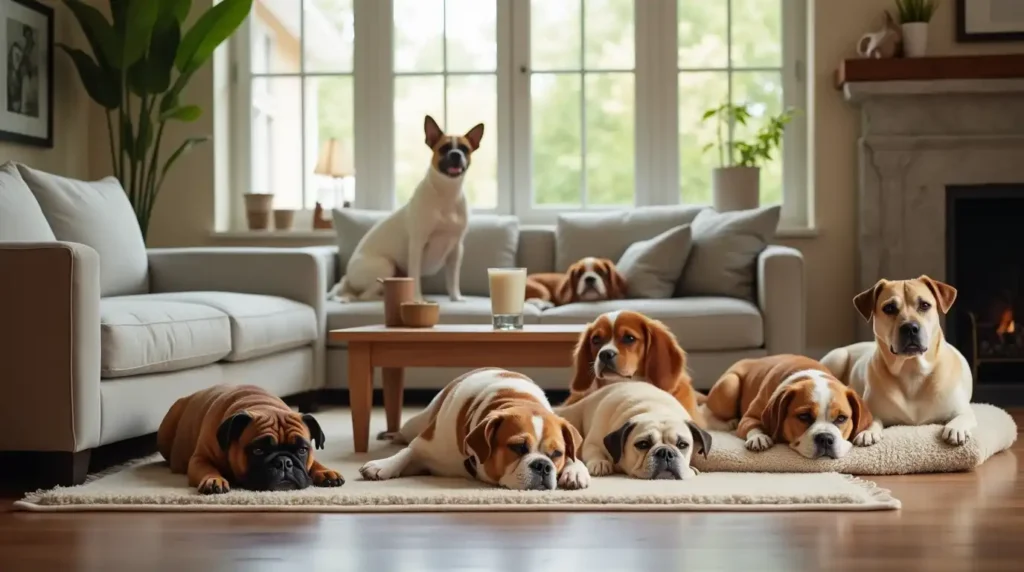Low Energy Dog Breeds: Top Breeds Care & Training
Dogs are known for their companionship, loyalty, and playful nature. However, not every dog is suited for an active lifestyle. Whether you’re living in a small apartment, have a busy schedule, or simply prefer a calm companion, low-energy dog breeds are ideal choices. These breeds are perfect for people who want a dog that can be content with minimal exercise and who loves to lounge around with their family.
In this guide, we will explore the best low-energy dog breeds, provide essential tips on how to care for them, and share training advice. If you’re looking for a laid-back, easy-to-manage dog, this article will help you find the perfect breed for your lifestyle.
Top Low-Energy Dog Breeds for Relaxed Lifestyles
When it comes to low-energy dogs, there are several breeds that stand out for their calm nature, affectionate demeanor, and minimal exercise requirements. These dogs are generally happy with shorter walks, indoor playtime, and plenty of relaxation. Here are some of the top breeds to consider.
1. French Bulldog: The Perfect Low-Energy Companion
French Bulldogs are a beloved low-energy breed known for their adorable, compact size and affectionate nature. They are perfect for people living in apartments or homes with limited outdoor space. Despite their playful demeanor, they don’t require much physical activity and are content with short walks or brief play sessions.
- Size: Small
- Exercise Needs: Low
- Personality: Loyal, friendly, and calm
- Best For: City dwellers, first-time dog owners, and families with young children
French Bulldogs enjoy snuggling up with their owners, and their compact size makes them an excellent choice for apartment living. They have a relaxed attitude and prefer lounging on the couch, making them the perfect companion for those who prefer a more laid-back pet.
2. Cavalier King Charles Spaniel: A Calm and Affectionate Breed
The Cavalier King Charles Spaniel is another popular low-energy dog breed that is known for its friendly, affectionate, and gentle personality. While they enjoy playing with their owners, they are not particularly active and are happy with short daily walks and lounging around the house.
- Size: Small
- Exercise Needs: Low
- Personality: Gentle, affectionate, and friendly
- Best For: Families, elderly individuals, and apartment dwellers
Cavalier King Charles Spaniels are ideal for people looking for a dog that can adapt to various living environments and doesn’t require constant attention. They are great lap dogs and enjoy being pampered by their owners. These dogs are also highly sociable and get along well with children and other pets.
3. English Bulldog: The Laid-Back Family Favorite
English Bulldogs are well-known for their laid-back personalities and calm demeanor. They may be one of the most iconic low-energy dog breeds, perfect for owners who are looking for a relaxed companion. English Bulldogs are generally content to stay indoors, sleep, and enjoy short walks.
- Size: Medium
- Exercise Needs: Low
- Personality: Affectionate, calm, and loyal
- Best For: Families, apartment living, and low-maintenance pet owners
Though Bulldogs may be slow-moving, they have a lot of love to give. They thrive on human companionship and are excellent pets for individuals or families who prefer a calm, easygoing dog. However, due to their short noses, they can suffer from breathing issues, so it’s important to keep exercise sessions short and avoid overexertion.
4. Basset Hound: The Easygoing, Low-Energy Hunter
The Basset Hound is a breed that is well-suited for a more relaxed lifestyle. Known for their droopy ears and sad eyes, Basset Hounds have a calm disposition and are generally not overly energetic. While they enjoy walks, they are more than content to spend most of their day lying around and relaxing.
- Size: Medium
- Exercise Needs: Low
- Personality: Calm, friendly, and affectionate
- Best For: Families, retirees, and those seeking a quiet companion
Basset Hounds are great pets for families or individuals who are looking for a dog that doesn’t require a lot of exercise but still provides companionship. Their friendly nature makes them excellent family dogs, and they are often easygoing with children and other pets.
5. Shih Tzu: The Ideal Low-Energy Lap Dog
Shih Tzus are small, friendly dogs with a calm personality. Originally bred as companion dogs, they are naturally low-energy and enjoy lounging around with their owners. While they enjoy short play sessions, they don’t need excessive exercise and are content with walks around the block or a bit of indoor play.
- Size: Small
- Exercise Needs: Low
- Personality: Friendly, affectionate, and calm
- Best For: Apartment living, first-time dog owners, and families with small children
Shih Tzus are one of the most popular small breeds, known for their love of human companionship. They are adaptable and can thrive in smaller spaces, making them a good choice for people who don’t have a large yard. They also enjoy grooming and can be an excellent choice for those who want a dog with a luxurious coat.
6. Pug: A Playful Yet Relaxed Low-Energy Dog
Pugs are small, charming dogs that are known for their funny, outgoing personalities. They are playful but not overly energetic and are generally happy with a few short walks and indoor playtime. Their affectionate nature makes them great companions for families and individuals who want a dog that loves to snuggle.
- Size: Small
- Exercise Needs: Low to moderate
- Personality: Playful, loving, and sociable
- Best For: Families, apartment dwellers, and elderly individuals
Pugs may be small in size, but they have a big personality! They enjoy spending time with their families, and they are typically easygoing and adaptable. However, they are prone to weight gain, so it’s important to monitor their diet and exercise routine.
Find your perfect four-legged friend. 🐶 Explore profiles, traits, and tips for every pup.

H2: How to Care for Low-Energy Dog Breeds
Looking for a calm, cuddly companion? 🐾 Discover which breeds fit your relaxed lifestyle.
Caring for a low-energy dog is relatively easy, but it’s essential to understand their unique needs in terms of diet, exercise, grooming, and healthcare. Here are some helpful tips to ensure your dog remains healthy and happy.
H3: 1. Proper Nutrition
Even though low-energy dogs generally require fewer calories than their high-energy counterparts, it’s important to feed them a well-balanced diet to maintain their health. Look for high-quality dog food that contains protein, healthy fats, and vitamins, and consult your veterinarian for guidance on portion sizes and dietary needs.
- Tip: Avoid overfeeding, as low-energy dogs can become overweight if their food intake is not properly managed.
Low-energy dogs don’t need a lot of food, but they still need the right nutrients to support their health. Focus on providing food that is appropriate for their age, size, and activity level.
H3: 2. Exercise and Mental Stimulation
Though low-energy dogs don’t require much physical activity, they still need mental stimulation to keep them happy. Engage your dog in activities that require problem-solving, such as puzzle toys or interactive games. Low-energy dogs tend to enjoy relaxed activities, so keep their exercise routine light and enjoyable.
- Tip: A short walk around the block or a brief game of fetch can be enough to keep your dog physically and mentally stimulated.
H3: 3. Regular Veterinary Check-ups
Routine visits to the veterinarian are crucial for maintaining your dog’s overall health. Regular check-ups help catch any potential health problems early and ensure that your dog receives the appropriate vaccinations and preventive care. Dental hygiene is especially important for low-energy dogs, as they may be more prone to dental issues.
- Tip: Keep up with regular vet visits and ensure your dog is up-to-date on vaccinations and flea/tick prevention.
H2: Training Tips for Low-Energy Dogs
Training a low-energy dog can be just as rewarding as training an active one, but you’ll need to approach it with a little more patience and understanding. Low-energy dogs are often very responsive to gentle training methods.
H3: 1. Positive Reinforcement
The most effective way to train low-energy dogs is through positive reinforcement. Use treats, praise, and affection to reward your dog for good behavior. This method encourages them to repeat desirable actions and fosters a strong bond between you and your pet.
- Tip: Keep training sessions short and sweet, as low-energy dogs may lose interest if sessions are too long.
H3: 2. Start Training Early
Like all dogs, low-energy breeds benefit from early socialization and training. Teach basic commands such as “sit,” “stay,” and “come,” and start reinforcing good behavior from an early age. Early training helps prevent problem behaviors and makes your dog easier to manage as they grow older.
- Tip: Consistency is key. Use the same commands and reward system each time to reinforce learning.
H3: 3. Manage Unwanted Behaviors
While low-energy dogs are generally easy-going, they may still develop unwanted behaviors, such as excessive barking or chewing. Address these behaviors early on by using redirection techniques or offering alternative activities to keep them engaged.
- Tip: When your dog exhibits unwanted behavior, redirect their attention to a toy or a more appropriate activity.
H2: Frequently Asked Questions (FAQs) about Low-Energy Dogs
H3: 1. Are low-energy dogs good for apartment living?
Yes, many low-energy dog breeds are ideal for apartment living. They don’t require a lot of space to run around and are generally content with short walks and indoor activities. Breeds like the French Bulldog, Cavalier King Charles Spaniel, and Pug are all great choices for apartment dwellers.
H3: 2. Do low-energy dogs need a lot of exercise?
No, low-energy dogs generally don’t require as much physical exercise as more active breeds. A short walk, some indoor playtime, and mental stimulation are usually enough to keep them healthy and happy. However, it’s still important to keep them engaged and provide light exercise to maintain their health.
H3: 3. How can I prevent my low-energy dog from becoming overweight?
To prevent your low-energy dog from becoming overweight, be mindful of their food intake and ensure they get enough exercise to maintain a healthy weight. Limit treats and stick to a regular feeding schedule. Regular walks and indoor playtime can also help keep them active.
Conclusion
Low-energy dog breeds are perfect companions for individuals or families who want a laid-back, affectionate pet that doesn’t require constant exercise. By choosing the right breed, providing proper care, and engaging in consistent training, you can enjoy the companionship of a dog that is content with a relaxed lifestyle. Whether you live in an apartment or simply prefer a calm and loving companion, these breeds offer the perfect balance of affection and ease.
Find your perfect four-legged friend 🐶 Explore detailed breed profiles and care tips.

